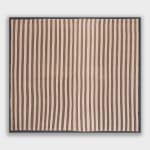Chimu Culture 1000-1470
Chimu Stripe Tunic, Circa. 1200AD
Camelid fibres
142 x 162 cm
55'9" x 63'7" in.
55'9" x 63'7" in.
CHI0003
Copyright of Paul Hughes Fine Arts
This tunic bears a bold striped colour field composition, one of the many geometric forms that became predominant in the early Nazca and later Huari period. Here the monochromatic stripes...
This tunic bears a bold striped colour field composition, one of the many geometric forms that became predominant in the early Nazca and later Huari period. Here the monochromatic stripes create a large-scale almost optical structure. The ancient Andean artists endlessly exploited the multiple possibilities of strips, squares and rectangles. This well-preserved tunic brings us clearly into the field of Abstract arts or Colour-Field art. We should not discard the possibility that this stunning abstract design was not merely the creation of people whose sharp eyes have the intuitive sense of colour, composition, and uncompromising originality. Rather, it was also an aesthetic solution which happens to coincide with our own criteria of beauty in the twentieth century.
Publications
Confluences in Art, 2019. Page. 37, 95.Join our mailing list
* denotes required fields
We will process the personal data you have supplied in accordance with our privacy policy (available on request). You can unsubscribe or change your preferences at any time by clicking the link in our emails.



